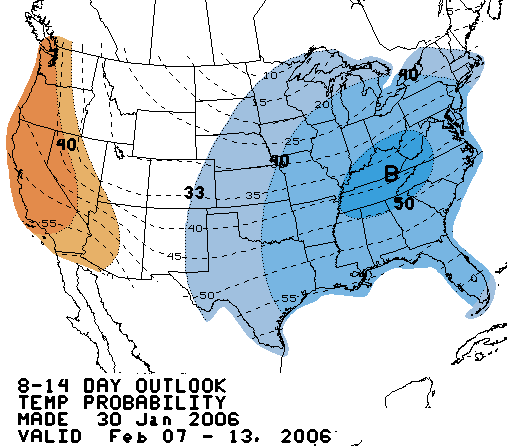Models Look Optimistic For Warmer Weather After Mid-Month
Tuesday, February 7th, 2006Signs are beginning to point towards the cold wave we’ve seen since late last week ending by President’s Day. Since the beginning of the month, upper air patterns have allowed colder Canadian air to infiltrate the Southeast, bringing an end to the warmer than normal weather we saw in January. The primary culprit has been a trough of low pressure over the Eastern seaboard.
Essentially, this is the opposite of what we had in January, when a ridge over the east coast kept temperatures warm. So far in February, we are 3.6 degrees colder, on average, than we were last month, although that’s still 1.7 degrees above normal.
Forecast models are predicting that the trough will move out by February 17th or so, allowing warmer Gulf Coast air to come back in, and raise afternoon temperatures back into the 60 degree range, and keep overnight lows above freezing. In addition, it looks like the Arctic Oscillation is moving towards the positive configuration we saw for most of January.
Of course, the models initially predicted that we would have the current cold spell sometime in late January, rather than what actually happened, and they could be wrong again. But, at least for the moment, the Climate Prediction Center says we have equal chances of above or normal temperatures from February 15th through the 21st, when our normal high should be 56 degrees.
On another note, the winter weather predicted for Monday turned out to be a bust. Forecasts of 1 to 3 inches of snow ended up with about an inch of cold rain. You had to go to Gilmer or Union Counties in North Georgia to see an inch of snow. The close in counties to metro Atlanta got just rain, while the northern metro saw a bit of sleet, but that was about it.
While it will be cold enough for snow over the next few days, the storms predicted for Wednesday night and Friday night are unlikely to have enough moisture to work with to do anything significant. As is typical, when cold blasts come out of the north, they can’t take advantage of Gulf moisture to produce any real snow.
Sphere: Related Content

 The map to the right illustrates the expected weather for 10 AM on Monday. Snow is expected for most of Northwest Georgia, including portions of Gwinnett. South, a mix of rain and snow is predicted. The Weather Service’s Point forecasts, which predicts weather down to a five mile radius of a given point, says that Lawrenceville, Duluth, Buford, and even up towards Gainesville can expect 1 to 3 inches of snow during the day, with a possible additional inch Monday night. However, Snellville gets 1 to 2 inches, and Loganville gets less than an inch.
The map to the right illustrates the expected weather for 10 AM on Monday. Snow is expected for most of Northwest Georgia, including portions of Gwinnett. South, a mix of rain and snow is predicted. The Weather Service’s Point forecasts, which predicts weather down to a five mile radius of a given point, says that Lawrenceville, Duluth, Buford, and even up towards Gainesville can expect 1 to 3 inches of snow during the day, with a possible additional inch Monday night. However, Snellville gets 1 to 2 inches, and Loganville gets less than an inch.


